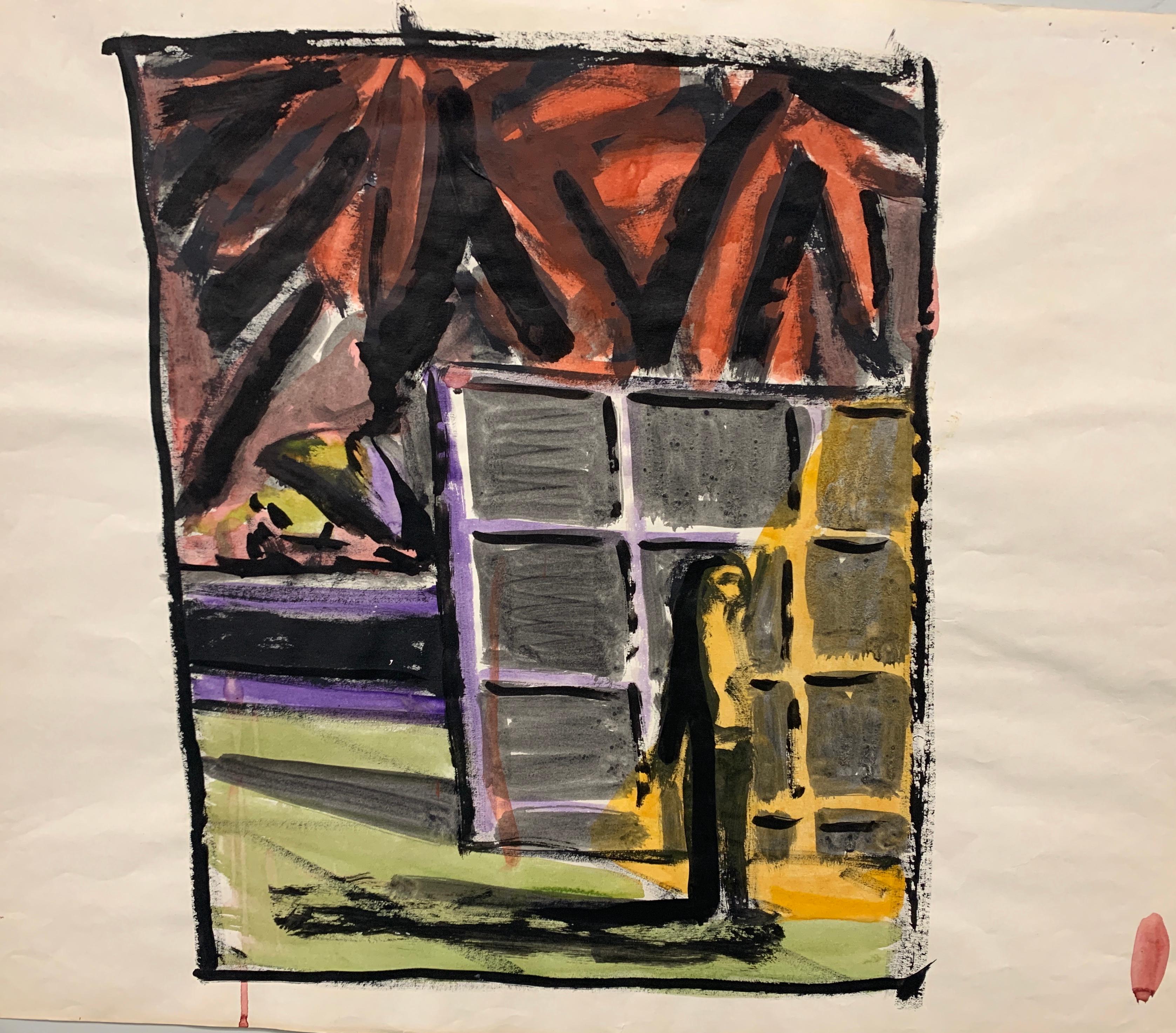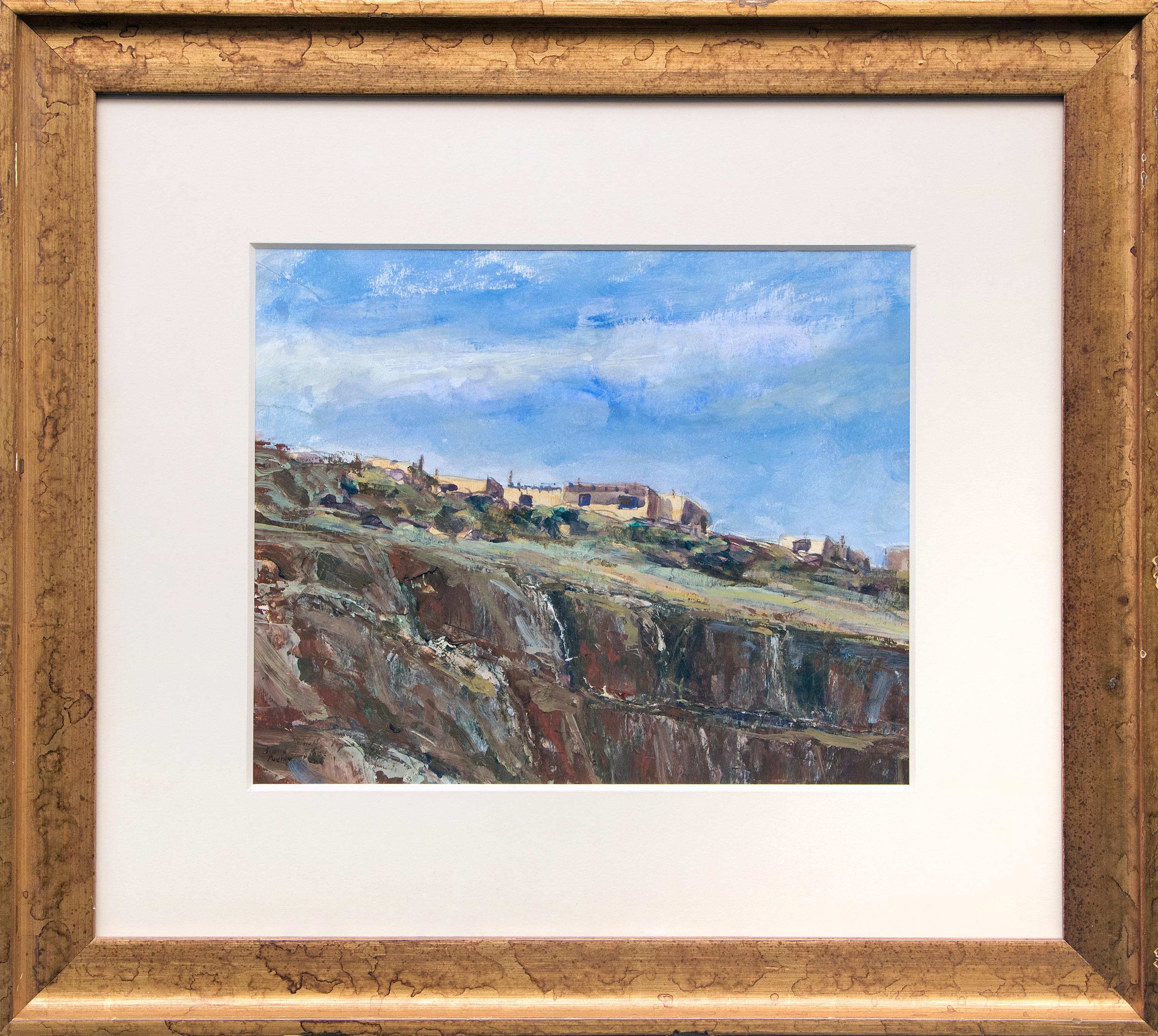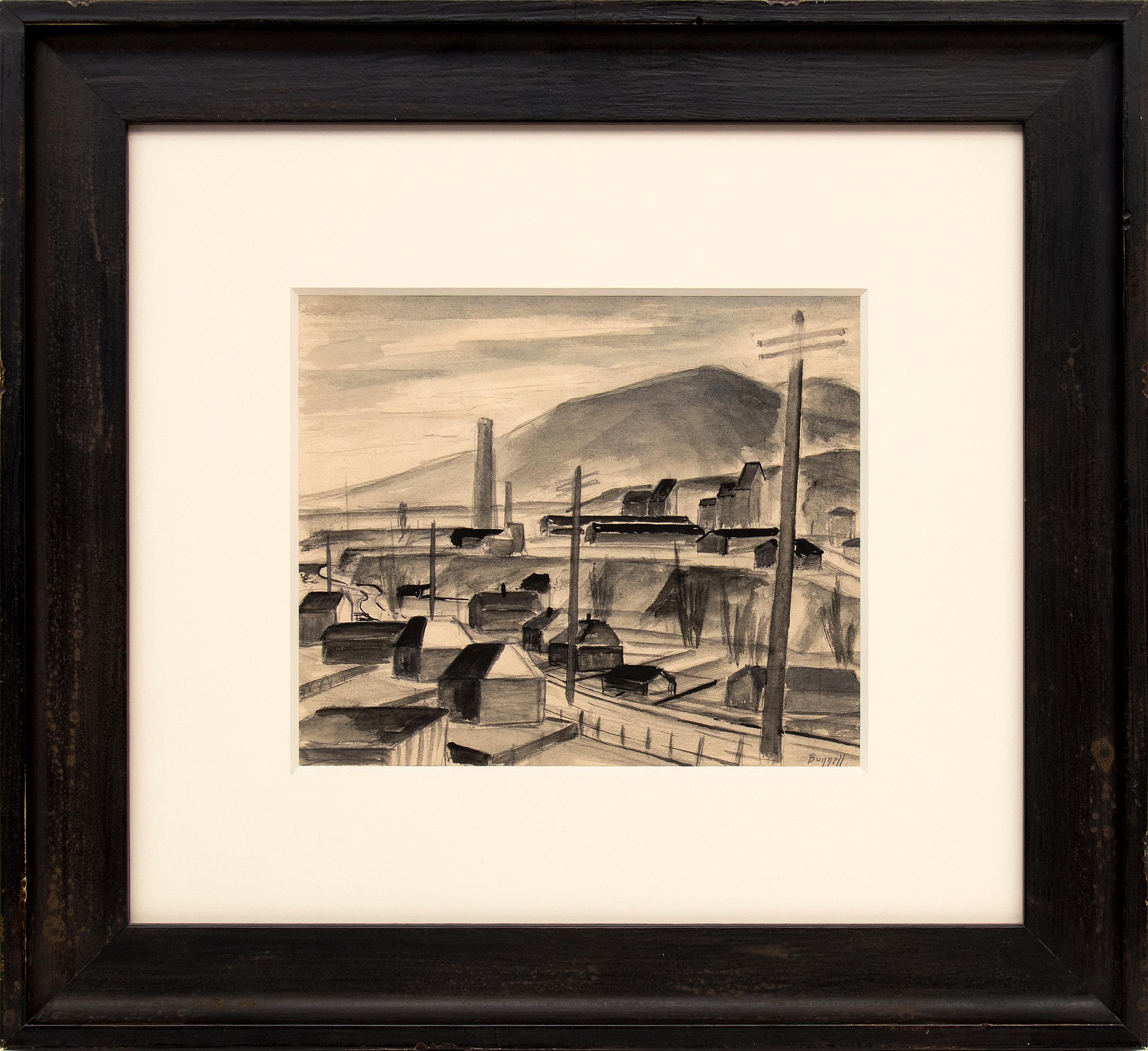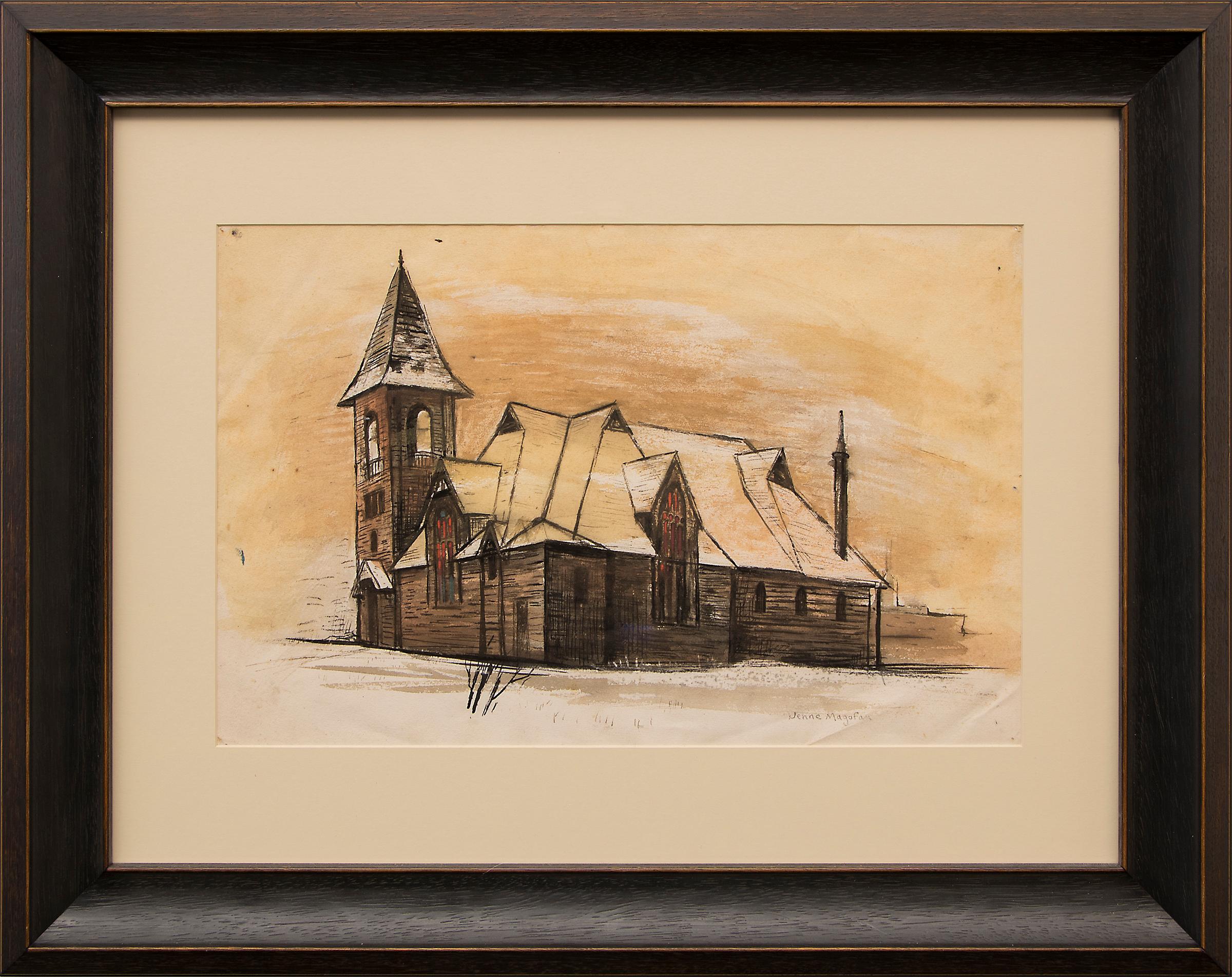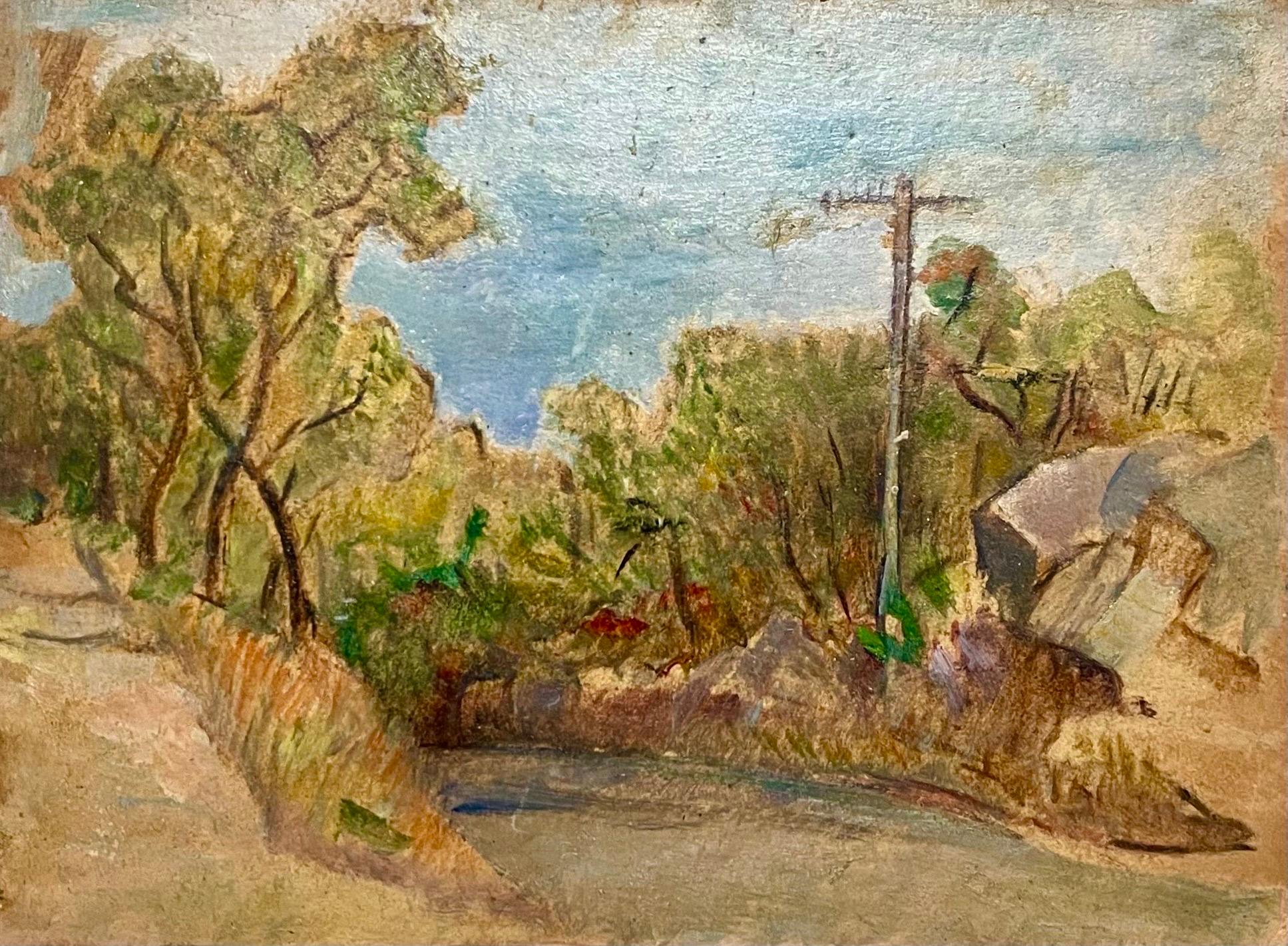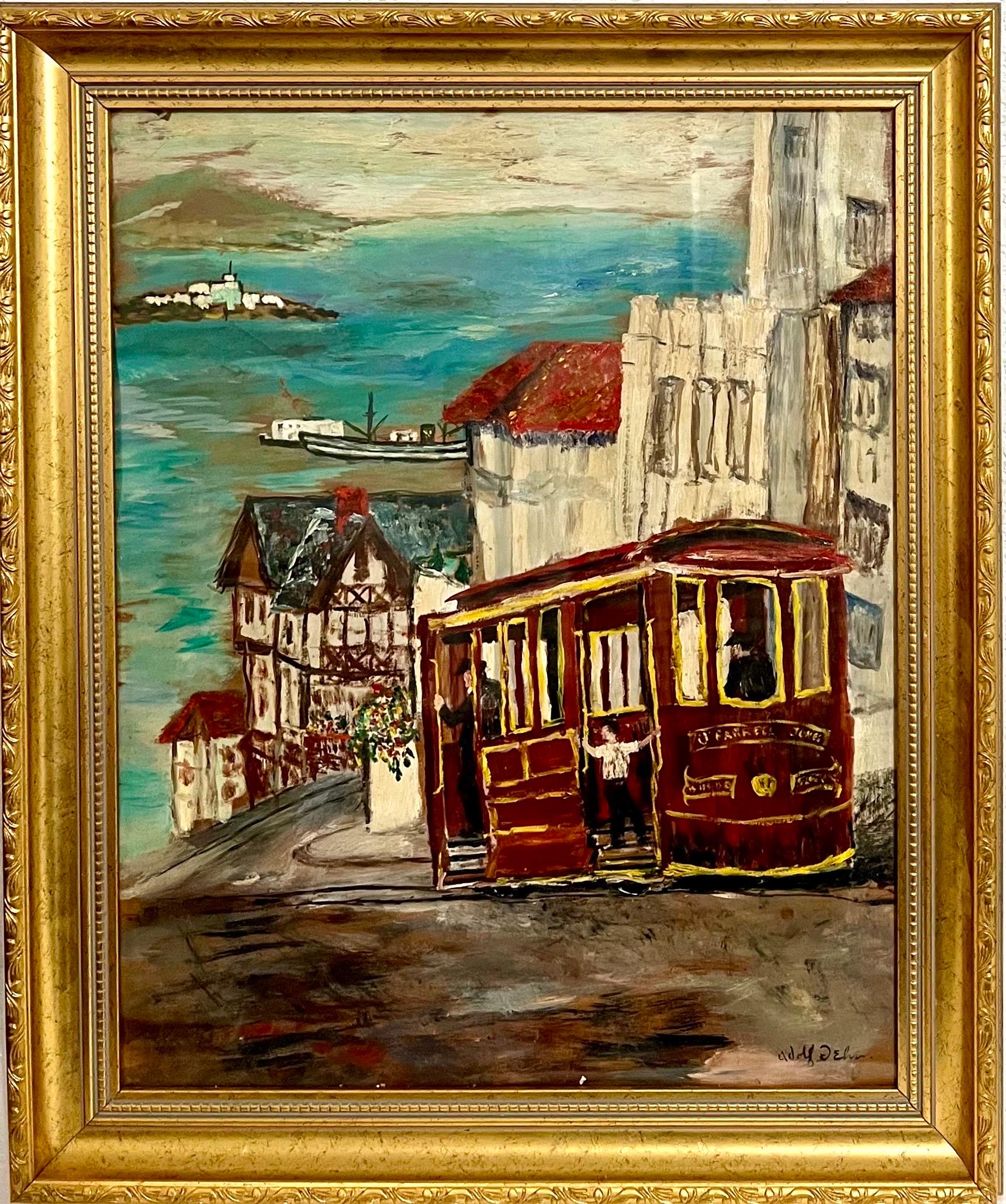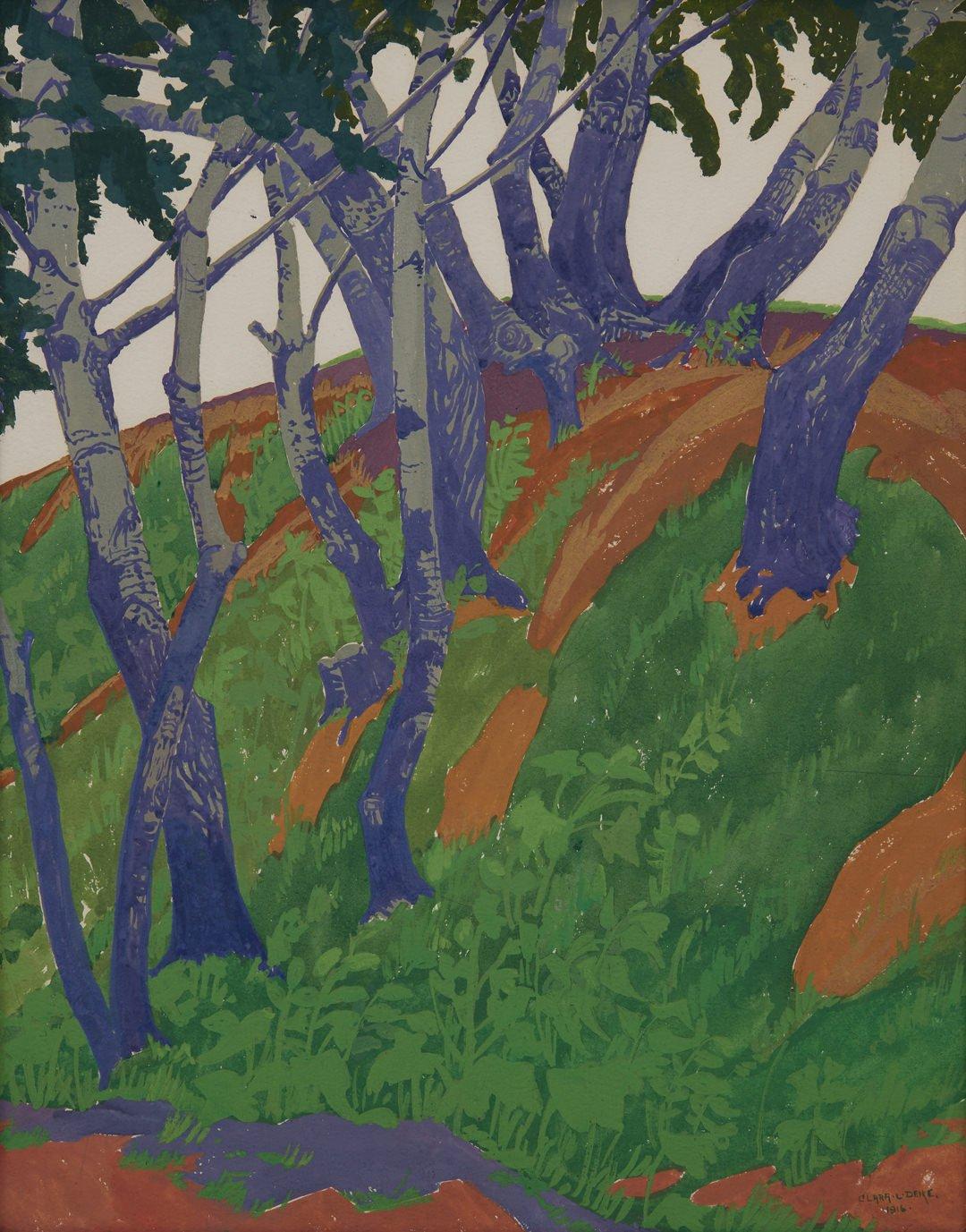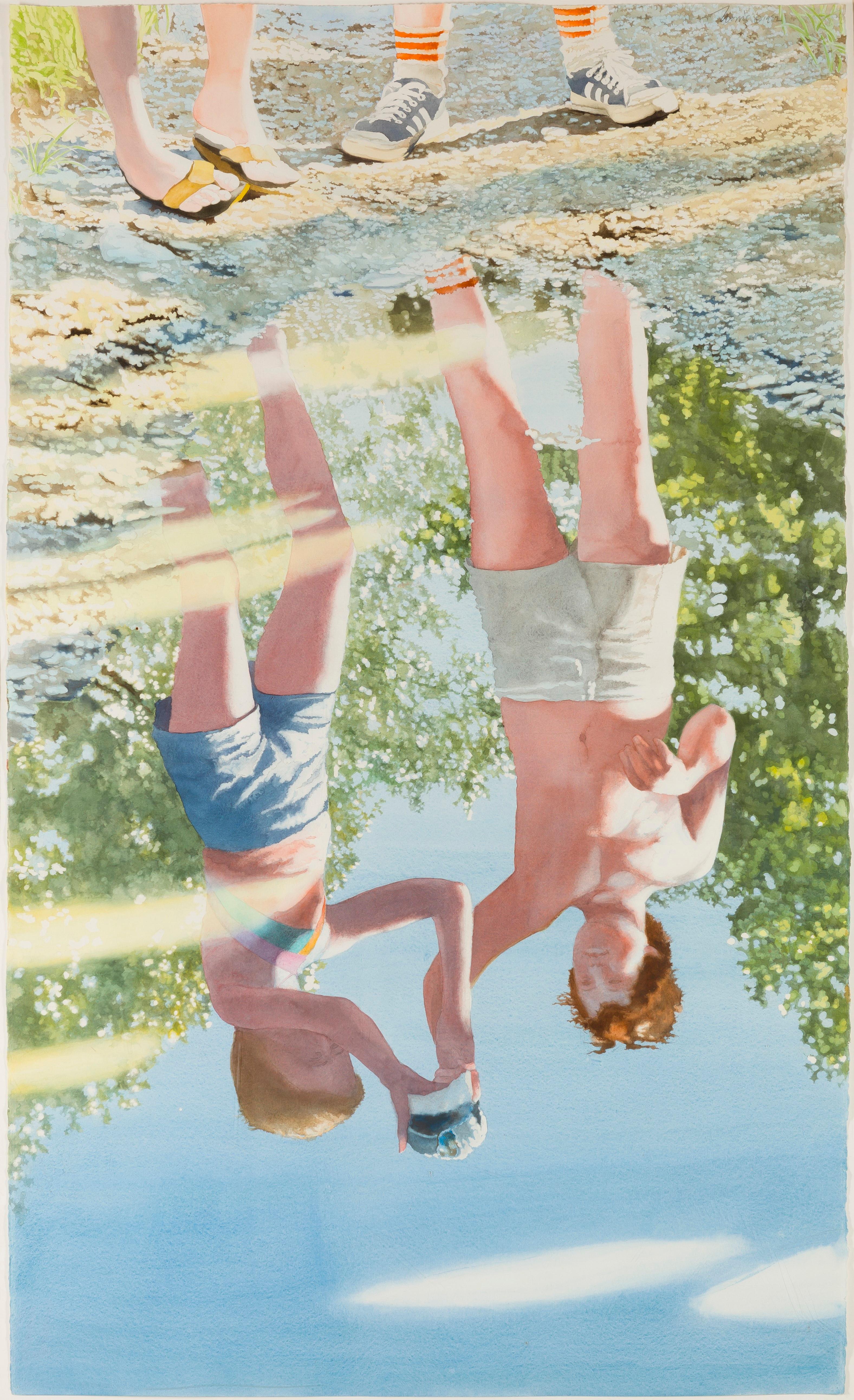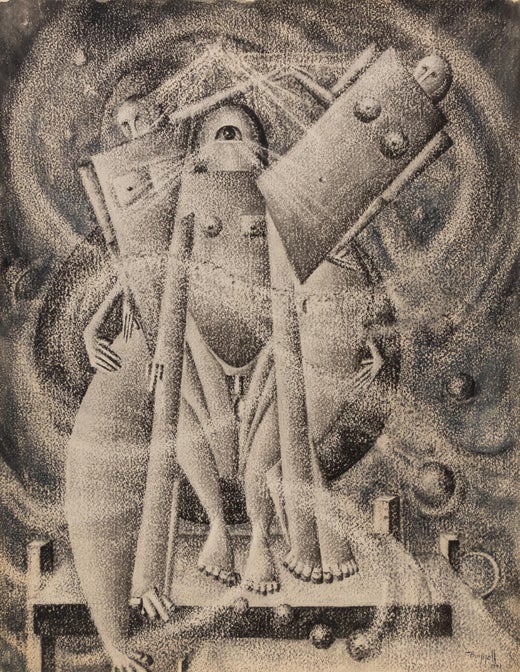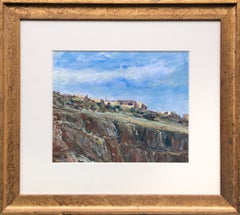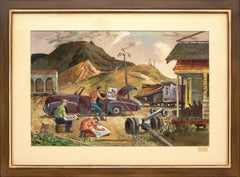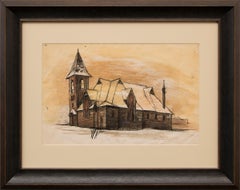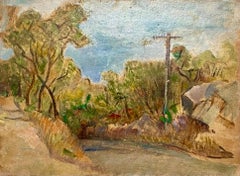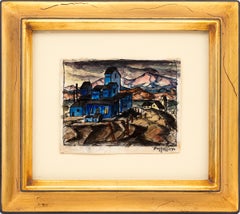
Cripple Creek Victor Mine Colorado, 1940 Watercolor Mountain Landscape Art
View Similar Items
Video Loading
Want more images or videos?
Request additional images or videos from the seller
1 of 16
Charles Ragland BunnellCripple Creek Victor Mine Colorado, 1940 Watercolor Mountain Landscape Art1940
1940
$3,250List Price
About the Item
- Creator:Charles Ragland Bunnell (1897-1968, American)
- Creation Year:1940
- Dimensions:Height: 10.25 in (26.04 cm)Width: 11.5 in (29.21 cm)Depth: 1.5 in (3.81 cm)
- Medium:
- Movement & Style:
- Period:
- Framing:Frame IncludedFraming Options Available
- Condition:
- Gallery Location:Denver, CO
- Reference Number:Seller: 258241stDibs: LU27310341622
Charles Ragland Bunnell
Charles Bunnell developed a love for art at a very young age. As a child in Kansas City, Missouri, he spent much of his time drawing. When he was unable to find paper he drew on walls and in the margins of textbooks for which he was often fined. Around 1915, Bunnell moved with his family to Colorado Springs, Colorado. He served in World War I and later used his GI Training to study at the Broadmoor Art Academy (later renamed the Colorado Springs Fine Arts Center) during 1922 and 1923. In 1922, he married fellow student, Laura Palmer. He studied with Ernest Lawson in 1927-1928 and, in the winter of 1928-1929, he served as Lawson’s assistant. In the late 1920’s, the Bunnell’s settled just west of Colorado Springs and 1928, they welcomed the first of their three children. Their one-acre homesite, which they referred to as “Old Home Place”, was situated between two sets of railroad tracks at the foot of Pike’s Peak. Charlie converted an old railroad boxcar into his studio, where he later gave lessons. Beginning in 1931, Bunnell spent a year and a half studying under Boardman Robinson. The two men clashed constantly due to a generation gap and markedly different philosophies. Robinson encouraged his students not to stray from realism and though Bunnell mastered Robinson’s preferred style of American Scene painting, he regularly irritated his professor with his abstract sketches. Bunnell taught at the Kansas City Art Institute during the summers of 1929, 1930, 1940, and 1941. Between 1934 and 1941, he painted and taught under federal projects which included assisting Frank Mechau on murals for the Colorado Springs Post Office. However, he did not take to mural making and, after criticism from Boardman Robinson about his use of “heavy daubs which have no place in mural work,” he abandoned mural-making altogether. By the late 1930’s, Bunnell’s work departed from the American Scene/Modernist style he was trained in towards abstraction. This is marked by his “Black and Blue” series, consisting of 83 abstracted ink and watercolors. Affected by the Second World War and the loss of his 10-year old son, Bunnell’s work of the early 1940’s took on a Transcendental and Surrealist tone. The works from this period are moody and readily reflect the political and personal turmoil experienced by the artist. In the late 1940’s, Bunnell began experimenting with Abstract Expressionism. He alone is credited with introducing Colorado Springs to the new style as it was excluded from the Fine Art Center’s curriculum by Boardman Robinson. Bunnell excelled in Abstract Expressionism and continued to evolve in the style through the 1950’s continuing to his death in 1968. He was recently recognized as a premier American Abstract Expressionist by his inclusion in the book American Abstract Expressionism of the 1950’s: An Illustrated Survey. © David Cook Galleries, LLC
About the Seller
5.0
Gold Seller
Premium sellers maintaining a 4.3+ rating and 24-hour response times
Established in 1979
1stDibs seller since 2013
289 sales on 1stDibs
Typical response time: 13 hours
Authenticity Guarantee
In the unlikely event there’s an issue with an item’s authenticity, contact us within 1 year for a full refund. DetailsMoney-Back Guarantee
If your item is not as described, is damaged in transit, or does not arrive, contact us within 7 days for a full refund. Details24-Hour Cancellation
You have a 24-hour grace period in which to reconsider your purchase, with no questions asked.Vetted Professional Sellers
Our world-class sellers must adhere to strict standards for service and quality, maintaining the integrity of our listings.Price-Match Guarantee
If you find that a seller listed the same item for a lower price elsewhere, we’ll match it.Trusted Global Delivery
Our best-in-class carrier network provides specialized shipping options worldwide, including custom delivery.More From This Seller
View All1970s Acoma Pueblo, New Mexico Southwest Landscape Gouache Painting, Signed Art
Located in Denver, CO
This stunning gouache painting by Wolfgang Pogzeba (1936-1982) captures the beauty of Acoma Pueblo, New Mexico, depicting a dramatic cliffside landsca...
Category
1970s American Modern Landscape Paintings
Materials
Gouache
Artists Sketching, California, 1940s Large Modernist Gouache Painting, Landscape
By Frederick Shane
Located in Denver, CO
This original 1940s American Modernist gouache painting, "Artists Sketching (California)," captures a dynamic scene of three artists at work against a majestic mountain backdrop. With expressive brushwork and a rich color palette, the piece embodies Frederick E. Shane’s signature blend of realism and modernist abstraction. Signed, titled, and dated by the artist in the lower margin, this remarkable artwork reflects the era’s Regionalist influence and the artist’s keen eye for capturing creative moments in the natural landscape.
The painting is professionally housed in a custom archival frame, ensuring long-term preservation. Frame dimensions: 25.5 x 37.5 x 1.5 inches. Image size: 20.25 x 29.75 inches.
Provenance: Estate of the Artist, Frederick Shane
About the Artist: Frederick E. Shane (1906-1992)
A celebrated Missouri Regionalist painter and printmaker, Frederick E. Shane was known for his compelling genre scenes, landscapes, seascapes, and portraits in a variety of media, including oil, watercolor, gouache, tempera, and lithography. While fundamentally a realist, Shane often incorporated elements of abstraction, expressionism, and surrealism, adding depth and emotion to his compositions.
During the summers of 1925-26, Shane studied under Randall Davey at the Broadmoor Academy in Colorado Springs, an institution founded in 1919 by philanthropists Spencer and Julie Penrose. Shane remained closely connected to the Colorado Springs Fine Arts Center, the Academy’s successor, throughout the 1940s and early 1950s, participating in Artists West of the Mississippi exhibitions and forming lasting friendships with key figures like Boardman Robinson and Adolph Dehn...
Category
1940s American Modern Landscape Paintings
Materials
Gouache
Golden Cycle Mill Colorado WPA Mining Watercolor, 1940s Grayscale Artwork
By Charles Ragland Bunnell
Located in Denver, CO
Original 1940s grayscale watercolor painting by American artist Charles Ragland Bunnell, capturing a semi-abstracted view of the Golden Cycle Mill in Colorado Springs, Colorado. Painted in subtle shades of black and gray, this unique WPA-era landscape combines industrial subject matter with expressive, modernist style. A striking piece of American regionalist art from the mid-20th century.
The work is presented in a custom black frame.
Framed dimensions: 18" H x 19 ½" W x 1 ⅜" D
Sight size: 8 ⅛" H x 9 ⅝" W
The Golden Cycle Mining and Reduction Company, depicted in this piece, was a major part of Colorado's mining boom in the early 20th century. Located in Colorado City (now part of Old Colorado City), the mill played a significant role in the region’s gold production and industrial development.
About the Artist: Charles Ragland Bunnell (1897–1968)
Charles Bunnell was a pivotal figure in Colorado’s 20th-century art scene. He worked across multiple styles—from representational landscapes to fully abstract compositions—and was one of the few artists in Colorado to successfully embrace the evolving trends of Modernism, Surrealism, and Abstraction after WWII.
Bunnell studied under notable artists at the Broadmoor Art Academy, including Ernest Lawson and Birger Sandzén. His early works, including regional landscapes and mining scenes like this one, showcase a mix of American Scene painting and semi-abstract structure. He later became known for his bold experimentation with color, form, and geometry, producing both expressive oils and ink-watercolor series such as Black and Blue.
He participated in multiple New Deal art...
Category
1940s American Modern Landscape Paintings
Materials
Watercolor
Church in Leadville, Colorado, 1930s Framed Landscape Watercolor & Ink Painting
By Jenne Magafan
Located in Denver, CO
This rare, original WPA-era painting, Church in Leadville (1938), was created by renowned Colorado and Woodstock modernist artist Jenne Magafan (1916-1952). The watercolor and ink wo...
Category
1930s American Modern Landscape Paintings
Materials
Archival Ink, Watercolor
Martyl Schweig 1942 Oil Painting, Victor, Colorado, Ghost Town Landscape
By Martyl Suzanne Schweig Langsdorf
Located in Denver, CO
This stunning original 1942 oil painting, titled "Victor, Colorado", is by acclaimed American artist Martyl Suzanne Schweig (1918–2013). A vibrant and historically rich landscape, this work captures the abandoned ghost town of Victor, Colorado, set against the majestic backdrop of the Rocky Mountains. Rendered in rich hues of green, gold, and earthy brown, Schweig brings to life the rugged beauty and quiet mystery of Colorado’s once-booming mining towns.
The painting was completed during a plein-air painting trip with noted artist Adolph Dehn...
Category
1940s American Modern Landscape Paintings
Materials
Oil, Masonite
Colorado Hill Town with Storm Clouds, 1940s Modernist Landscape, Lush Green
By Paul Kauver Smith
Located in Denver, CO
This WPA-era signed oil painting by Paul K. Smith captures a stormy summer landscape in Colorado, featuring houses and lush trees under dramatic storm clouds. Painted in rich shades ...
Category
1940s American Modern Landscape Paintings
Materials
Oil
You May Also Like
Society of Six Street Scene - Figurative Abstract
By Bernard Von Eichman
Located in Soquel, CA
Stunning New York City urban modernist watercolor titled "Summer Afternoon Stroll" by Society of Six artist Bernard Von Eichman (American, 1899-1990), 1...
Category
1930s American Modern Landscape Paintings
Materials
Archival Paper, Watercolor
$6,076 Sale Price
20% Off
"Union Square" NYC American Scene Social Realism Modernism WPA Mid-20th Century
By Agnes Hart
Located in New York, NY
"Union Square" NYC American Scene Social Realism Modernism WPA Mid-20th Century
Agnes Hart (American, 1912-1979)
"Union Square, New York City"
Sight: 14 1/2 x 21 1/2 inches
Gouache...
Category
1940s American Modern Landscape Paintings
Materials
Gouache, Board
1950s "Figure in Shadow" Figurative Gouache Painting America Modernist
By Donald Stacy
Located in Arp, TX
Donald Stacy
"Figure in Shadow"
c.1950s
Gouache paint on paper
24" x 18" unframed
Unsigned
Came from artist's estate
Donald Stacy (1925-2011) New Jersey
Studied: Newark School of Fine Art
The Art Students League
Pratt Graphic Arts Center
University of Paris 1953-54
University of Aix-en-Provence 1954-55
Faculty: Art Department of the New School
Museum of Modern Art
School of Visual Arts
Stacy Studio Workshop
Exhibitions: Grand Central Moderns
George Wittenborn
The New School
Print Exhibitions, Chicago
University of Oklahoma
Honolulu Museum
Monclair Museum
Wisconsin State College
Louisiana Art...
Category
Mid-20th Century American Modern Figurative Paintings
Materials
Paper, Gouache
Simka Simkhovitch WPA Artist Oil Painting Gouache American Modernist Powerline
By Simka Simkhovitch
Located in Surfside, FL
Simka Simkhovitch (Russian/American 1893 - 1949)
This came with a small grouping from the artist's family, some were hand signed some were not.
These were studies for larger paintings.
Simka Simkhovitch (Симха Файбусович Симхович) (aka Simka Faibusovich Simkhovich) (Novozybkov, Russia May 21, 1885 O.S./June 2, 1885 N.S.—Greenwich, Connecticut February 25, 1949) was a Ukrainian-Russian Jewish artist and immigrant to the United States. He painted theater scenery in his early career and then had several showings in galleries in New York City. Winning Works Progress Administration (WPA) commissions in the 1930s, he completed murals for the post offices in Jackson, Mississippi and Beaufort, North Carolina. His works are in the permanent collections of the Dallas Museum of Art, the National Museum of American Art and the Whitney Museum of American Art. Born outside Kyiv (Petrograd Ukraine) into a Jewish family who owned a small department store. During a severe case of measles when he was seven, Simcha Simchovitch sketched the views outside his window and decided to become an artist, over his father's objections. Beginning in 1905, he studied at the Grekov Odessa Art School and upon completion of his studies in 1911 received a recommendation to be admitted to the Imperial Academy of Arts. Though he enrolled to begin classes in architecture, painting, and sculpture at the Imperial Academy, he was dropped from the school roster in December because of the quota on the number of Jewish students and drafted into the army. Simchovitch served as a private in the 175th Infantry Regiment Baturyn [ru] until his demobilization in 1912. Re-enrolling in the Imperial Academy, he audited classes.
Simka Simkhovitch exhibited paintings and sculptures in 1918 as part of an exhibition of Jewish artists and in 1919 placed 1st in the competition "The Great Russian Revolution" with a painting called "Russian Revolution" which was hung in the State Museum of Revolution. In 1922, Simkha Simkhovitch exhibited at the International Book Fair in Florence (Italian: Fiera Internazionale del Libro di Firenze). In 1924, Simkhovitch came to the United States to make illustrations for Soviet textbooks and decided to immigrate instead. Initially he supported himself by doing commercial art and a few portrait commissions. In 1927, he was hired to paint a screen for a scene in the play "The Command to Love" by Fritz Gottwald and Rudolph Lothar which was playing at the Longacre Theatre on Broadway. Art dealers began clamoring for the screen and Simkhovitch began a career as a screen painter for the theater. Catching the attention of the screenwriter, Ernest Pascal, he worked as an illustrator for Pascal, who then introduced him to gallery owner, Marie Sterner. Simkhovitch's works appeared at the Marie Sterner Gallery beginning with a 1927 exhibit and were repeated the following year. Simkhovitch had an exhibit in 1929 at Sterner's on circus paintings. In 1931, he held a showing of works at the Helen Hackett Gallery, in New York City and later that same year he was one of the featured artists of a special exhibit in San Francisco at the California Palace of the Legion of Honor in Lincoln Park. The exhibit was coordinated by Marie Sterner and included four watercolors, including one titled "Nudes". He is of the generation of Russian Soviet artists such as Isaac Pailes, Serge Charchoune, Marc Chagall, Chana Orloff, Isaac Ilyich Levitan, and Ossip Zadkine.
In 1936, Simkhovitch was selected to complete the mural for the WPA Post office project in Jackson, Mississippi. The mural was hung in the post office and courthouse in 1938 depicted a plantation theme. Painted on the wall behind the judge’s bench, “Pursuits of Life in Mississippi”, a depiction of black workers engaged in manual labor amid scenes of white professionals and socialites, was eventually covered over in later years during renovations due to its stereotypical African American imagery. Simka painted what he thought was typical of Jackson. His impression of pre-civil rights Mississippi was evidently Greek Revival column houses, weeping willow trees, working class families, and the oppression of African Americans. He painted African American men picking cotton, while a white man took account of the harvest and a white judge advised a white family, calling it Pursuits of Life in Mississippi.
Though clearly endorsed by the government and initially generally well-received, the mural soon raised concerns with locals as the climate toward racial segregation began to change. The main concern was whether depictions that show African Americans in subjugated societal roles should be featured in a courtroom. The following year, his painting "Holiday" won praise at an exhibition in Lincoln, Nebraska. In 1940, Simkhovitch's second WPA post office project was completed when four murals, "The Cape Lookout Lighthouse and the Orville W. Mail Boat", "The Wreck of the Crissie Wright", "Sand Ponies" and "Canada Geese" were installed in Beaufort, North Carolina. The works were commissioned in 1938 and did not generate the controversy that the Jackson mural had. The main mural is "The Wreck of the Crissie Wright" and depicts a shipwreck which had occurred in Beaufort in 1866. "The Cape Lookout Lighthouse and the Orville W. Mail Boat" depicted the lighthouse built in 1859 and the mail boat that was running mail during the time which Simkhovitch was there. The boat ran mail for the area until 1957. "Sand Ponies" shows the wild horses common to the North Carolina barrier islands and "Canada Geese" showed the importance of hunting and fishing in the area. All four murals were restored in the 1990s by Elisabeth Speight, daughter of two other WPA muralists, Francis Speight...
Category
1930s American Modern Landscape Paintings
Materials
Oil, Board, Gouache
San Francisco Cable Car WPA Artist Adolf Dehn Modernist Art Gouache Oil Painting
By Adolf Dehn
Located in Surfside, FL
ADOLF ARTHUR DEHN (American, 1895-1969)
San Francisco Bay Area street scene, with Trolley, Streetcar, Cable Car with bay and Alcatraz Island in background.
Hand signed LRC.
Sight 19" x 15", overall 23" x 19".
Adolf Dehn (November 22, 1895 – May 19, 1968) was an American artist known mainly as a lithographer. Throughout his artistic career, he participated in and helped define some important movements in American art, including regionalism, social realism, and caricature. A two-time recipient of the Guggenheim Fellowship, he was known for both his technical skills and his high-spirited, droll depictions of human foibles.
Adolph Dehn was born in 1895 in Waterville, Minnesota. He began creating artwork at the age of six, and by the time of his death had created nearly 650 images.
Dehn went to the Minneapolis School of Art (known today as the Minneapolis College of Art and Design), where he met and became a close friend of Wanda Gag. In 1917 he and Gág were two of only a dozen students in the country to earn a scholarship to the Art Students League of New York. He was drafted to serve in World War I in 1918, but declared himself a conscientious objector and spent four months in a guardhouse detention camp in Spartanburg, SC and then worked for eight months as a painting teacher at an arm rehabilitation hospital in Asheville, NC. Later, Dehn returned to the Art Students League for another year of study and created his first lithograph, The Harvest.
In 1921 Dehn's lithographs were featured in his first exhibition at Weyhe Gallery in New York City. From 1920 to 1921 in Manhattan, he was connected to New York's politically left-leaning activists. In 1921, he went to Europe. In Paris and Vienna he belonged to a group of expatriate intellectuals and artists, including Andrée Ruellan, Gertrude Stein, and ee cummings...
Category
1930s American Modern Figurative Paintings
Materials
Gouache, Oil
Mid Century Modernist Watercolor Landscape with Horse, Cleveland School
By William Sommer
Located in Beachwood, OH
William Sommer (American, 1867–1949)
Spring Beauty
Watercolor on paper
Signed lower right
12.5 x 17 inches
18 x 22.75 inches, framed
William Sommer is seen as a key person in bringi...
Category
Mid-20th Century American Modern Figurative Paintings
Materials
Watercolor
Recently Viewed
View AllMore Ways To Browse
C W Smith
Mountain Meadow
Park City Utah
Edward Walker
French Caribbean Art
Laguna Beach Plein Air Paintings
Laguna Beach Plein Air
Matisse Tree
May Stevens
Mitchell And Gold
Scottish Highlands Oil Painting
Winter Landscapes Russian
1837 Oil
Children Playing On Beach
American Farmhouse Painting
English Cottage Oil Painting
Paintings Of Tall Ships
Photorealism Landscape

